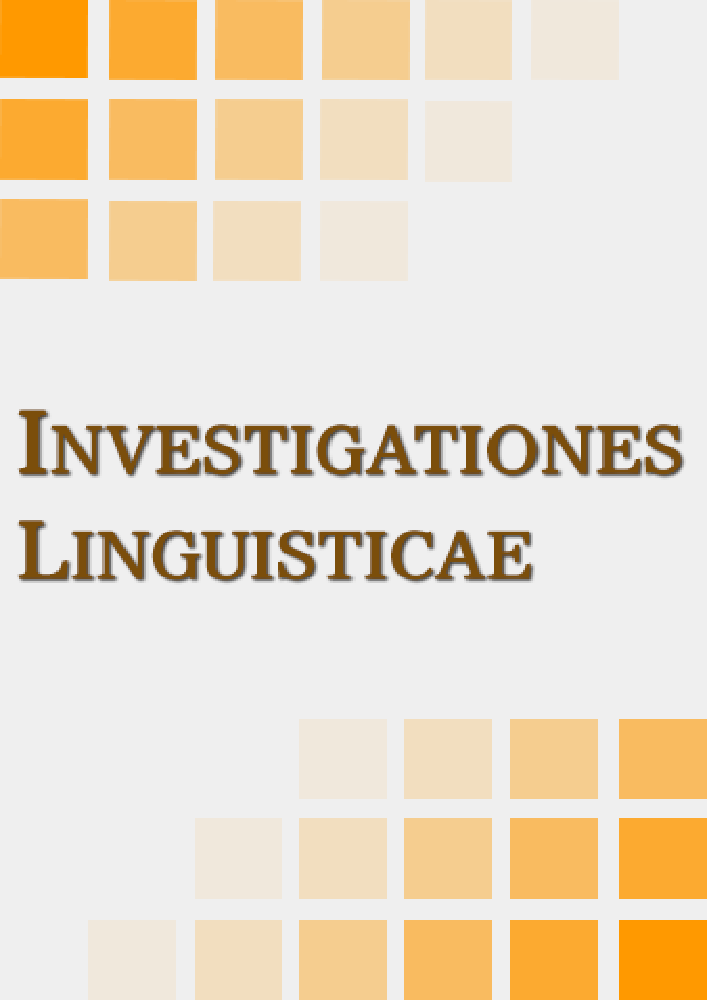Abstrakt
Light verb constructions are typically interpreted as idiom-like, fixed patterns in the literature (see e.g. Forgács 2015). However, corpus data suggest that such constructions may also display variability, potentially inviting a study in terms of synonymy. For instance, this is the case with barátságot köt [lit. ‘tie a friendship’] ~ barátságot sző [lit. ‘weave a friendship’] ~ barátságot épít [lit. ‘build a friendship’], all meaning ‘make friends’.
In the present case study, I explore patterns of the structure N-ba/be ‘into N’ + V, in particular feledésbe V ‘become forgotten’ (where feledésbe means ‘into oblivion’), homályba V ‘become obscure’ (where homályba means ‘into obscurity’) and sötétségbe V ‘become dark’ (where sötétségbe means ‘into darkness’). More specifically, I examine variants of these LVCs (e.g. homályba vész [lit. ‘be lost into obscurity’] ~ homályba szürkül [‘fade into oblivion’]), yielding synonym groups. Primarily using corpus data from the Hungarian National Corpus, I seek to find out how these three synonym groups are related semantically, and how their similarities and differences can be described by studying i. central and marginal patterns within them and ii. verbal lexemes (elfelejtődik ‘become forgotten’, elhomályosul ‘become obscure’ and elsötétedik ‘become dark’, respectively) with which they are synonymous.
Bibliografia
Sources
MNSZ2 = Magyar Nemzeti Szövegtár 2. [Hungarian National Corpus 2.] http://corpus.nytud.hu/mnsz
Mazsola = Mazsola – a magyar igei bővítményszerkezet vizsgálata. [Mazsola. Studying the argument structure of Hungarian verbs.] http://corpus.nytud.hu/mazsola
Nsz. = Ittzés Nóra (ed.) A magyar nyelv nagyszótára. I–VI. 2006–2017. [Comprehensive Dictionary of Hungarian.] Budapest: Akadémiai Kiadó.
Bowern, Claire 2008. “The diachrony of complex predicates.” Diachronia 25: 161-185.
Butt, Miriam and Lahiri, Aditi 2013. “Diachronic pertinacity of light verbs.” Lingua 135: 7-29.
Caro, Elena Martínez and Arús-Hita, Jorge 2020. “Give as a light verb.” Functions of Language. 27, nr 3: 280-306.
Cetnarowska, Bożena 2014. “How light are »light« verbs in composite predicates?” In Łyda, Andrzej and Drożdż, Grzegorz (eds): Dimensions of the word. Newcastle upon Tyne: Cambridge Scholars Publishing. 28-46.
Dabrowska, Ewa and Divjak, Dagmar (eds) 2015. Handbook of Cognitive Linguistics. Berlin/München/Boston: De Gruyter Mouton.
Dobos, Csilla 2009. Funkcióigés szerkezetek. [Light verb constructions.] Miskolc.
Dogruöz, A. Seza and Gries, Stefan Th. 2012. “Spread of on-going changes in an immigrant language. Turkish in the Netherlands.” Review of Cognitive Linguistics 10, nr 2: 401-426.
Forgács, Tamás 2015. “Frazeológiai egységek »könnyű igékkel«.” [Phraseological units with »light verbs«.] In Bárth, M. J., Bodó, Cs., Kocsis Zs. (eds): A nyelv dimenziói. Tanulmányok Juhász Dezső tiszteletére. Budapest: ELTE BTK. 462-472.
Forgács, Tamás 2007. Bevezetés a frazeológiába. A szólás- és közmondáskutatás alapjai. [Introduction to phraseology. The basics of research on proverbs.] Budapest: Tinta Könyvkiadó.
Horváth, Katalin 1996. “Hogyan bővülnek a szinonimasorok? A poliszémia és a szinonímia összefüggéséről.” [How do ranges of synonyms expand? On the relationship between polysemy and synonymy.] Magyar Nyelv 92, nr 3: 325-331.
Hrenek, Éva 2016. A funkcióigés szerkezetek a metaforikus jelentésű igei szerkezetek rendszerében. [Light verb constructions in the system of metaphorical verbal constructions.] MA thesis. Manuscript. Budapest: ELTE BTK Alkalmazott Nyelvészeti Tanszék.
Hrenek, Éva 2019. “On the meaning of light verbs: Hungarian light verb constructions within the system of verbal constructions with metaphorical meanings.” Jezyk – Komunikacja – Informacja / Language – Communication – Information 14: 14-32.
Hrenek, Éva 2021a. “Szinonímia a feledésbe + ige típusú szerkezetek körében.” [Synonymy in constructions of the type feledésbe + verb.] Magyar Nyelvőr 145, nr 3. Forthcoming.
Hrenek, Éva 2021b. “Semantic motivations of the organization of ranges of synonyms involving light verbs. Synonymous constructions of the ‘feledésbe + verb’ type.” Studia Linguistica Hungarica 33. (http://slh.elte.hu) Forthcoming.
Hrenek, Éva 2021c. “Az ige variálódására épülő szinonim funkcióigés szerkezetek és szinonimaköreik egymással való összefüggései.” [Synonymous light verb constructions built on the variation of verbs and interconnections of their ranges of synonyms.] Ösvények 2021. (http://osvenyek.elte.hu) Forthcoming.
Ittzés, Máté 2015. “Light verb constructions in Vedic.” Manas. Studies into Asia and Africa 2, nr 1. http://manas.bg/en/tradition-and-modernity-indian-culture/light-verb-constructions-vedic#nav2
Kelemen, Sándor, Ladányi, Mária and Spannraft, Marcellin 1985. “Igei jelentéselemzések.” [Semantic analyses of verbs.] Magyar Nyelvőr 218-234.
Keszler, Borbála 2000. “A szófaji felosztás problémái.” [Issues of the assignment of words into word classes.] In Keszler, Borbála (ed.): Magyar grammatika. Budapest: Nemzeti Tankönyvkiadó. 70-76.
Kövecses, Zoltán 2002. Metaphor. A practical introduction. New York: Oxford University Press.
Ladányi, Mária 1993. “Az eszik ige és szinonimái. Általános mozzanatok szerepe a metaforizációban és a szinonimitásban.” [Eszik ‘eat’ and its synonyms. The role of general aspects in grammaticalization and metaphorization.] In Hadas, Emese (ed.): A metaforikus és a hipotetikus jelentés további konkretizációja. A „Nyelvi mozgásformák dialektikája” kutatócsoport munkái 10. Budapest: ELTE BTK Általános és Alkalmazott Nyelvészeti Tanszék. 13-41.
Ladányi, Mária 2004. “Rendszeres igei poliszémia.” [Systematic polysemy of verbs.] In Kiefer, Ferenc (ed.): Strukturális magyar nyelvtan 4. A szótár szerkezete. Budapest: Akadémiai Kiadó. 269-320.
Langacker, Ronald W. 2009. “Cognitive (Construction) Grammar.” Cognitive Linguistics 20, nr 1: 167-176.
Lanstyák, István 2019. “A funkcióigés szerkezetek néhány általános kérdéséről.” [On some general aspects of light verb constructions.] Fórum Társadalomtudományi Szemle 21, nr 4: 61-91.
Murphy, Lynne 2003. “Synonymy and similarity.” In Murphy, Lynne: Semantic relations and the lexicon. Cambridge: Cambridge University Press. 133-169.
NyMDK. 1–11. = A „Nyelvi mozgásformák dialektikája” kutatócsoport munkái 1–11. [Works of the Research group on the dialectics of the motion forms in language, vols. 1–11.] Budapest: ELTE BTK Általános és Alkalmazott Nyelvészeti Tanszék. 1982–1994.
J. Soltész, Katalin 1959. Az ősi magyar igekötők (meg, el, ki, be, fel, le). [The ancient Hungarian verbal particles (meg, el, ki, be, fel, le).] Budapest: Akadémiai Kiadó.
Szilágyi N., Sándor 1996. Hogyan teremtsünk világot? Rávezetés a nyelvi világ vizsgálatára. [How to create a world?] Kolozsvár: Erdélyi Tankönyvtanács.
Xu, Wen and Taylor, John R. (eds) 2021. The Routledge Handbook of Cognitive Linguistics. London / New York: Routledge.
Zsilka, János 1975. A jelentés szerkezete. [The structure of meaning.] Budapest: Akadémiai Kiadó.
Zsilka, János 1978. Jelentés-integráció. [Semantic integration.] Budapest: Akadémiai Kiadó.
